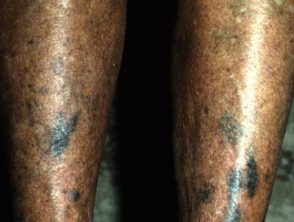What is drug-induced skin? pigmentation?
Drug-induced skin pigmentation accounts for 10-20% of all cases of acquired infection. hyperpigmentation. Pigmentation can be induced by a wide variety of medications; the main ones implicated include non-steroidal anti-steroidsinflammatory drugs (NSAID), phenytoin, antimalarials, amiodarone, antipsychotics, cytotoxic drugs, tetracyclines and heavy metals.
Some drugs can cause fixed drugs eruption, which is followed by located hyperpigmentation and gradually fades.
Drug-induced pigmentation

Minocycline pigmentation

Minocycline pigmentation

Fixed drug reaction to trimethoprim + sulfamethoxazole

since

Reaction to medications

Antiepileptic carotenemia
What causes drug-induced skin pigmentation?
Several mechanisms may be involved in drug-induced skin pigmentation changes.
- Certain heavy metals, such as iron, silver, and gold, can deposit in the dermis next damage to dermal vessels. If deposited in sufficient quantities, a distinctive change in skin color can be seen without any significant increase in melanin.
- Some drugs react with melanin to form a drug.pigment complex. Exposure to sunlight often stimulates sun-induced melanin synthesis forming these complexes.
- Some drugs induce hypermelanosis (accumulation of melanin) as a nonspecific post-inflammatory change in predisposed individuals. This is often made worse by sun exposure.
- Some drugs induce pigmentation directly by accumulating and/or reacting with other substances in the skin.
What are the clinical characteristics of drug-induced skin pigmentation?
The clinical characteristics of drug-induced skin pigmentation are highly variable depending on the drug involved. A wide range of patterns and shades can be formed.
| Drug/drug group | Clinical features |
|---|---|
| Heavy metals |
|
| Tetracyclines (minocycline) |
|
| Antipsychotics (chlorpromazine and related phenothiazines) |
|
| Phenytoin/anticonvulsants |
|
| Antimalarials |
|
| Cytotoxic drugs |
|
| Amiodarone |
|
| NSAID |
|
What is the treatment for drug-induced skin pigmentation?
Drug-induced skin pigmentation can become cosmetically disfiguring. In many cases, once the offending drug is discontinued, discoloration of the lesions occurs. However, the pigmentation can last a long time or become permanent. Because many medications that induce skin pigmentation also cause photosensitivity reactions, sun protection is generally recommended.
To be The treatment has been successful in treating amiodarone-induced skin pigmentation.

